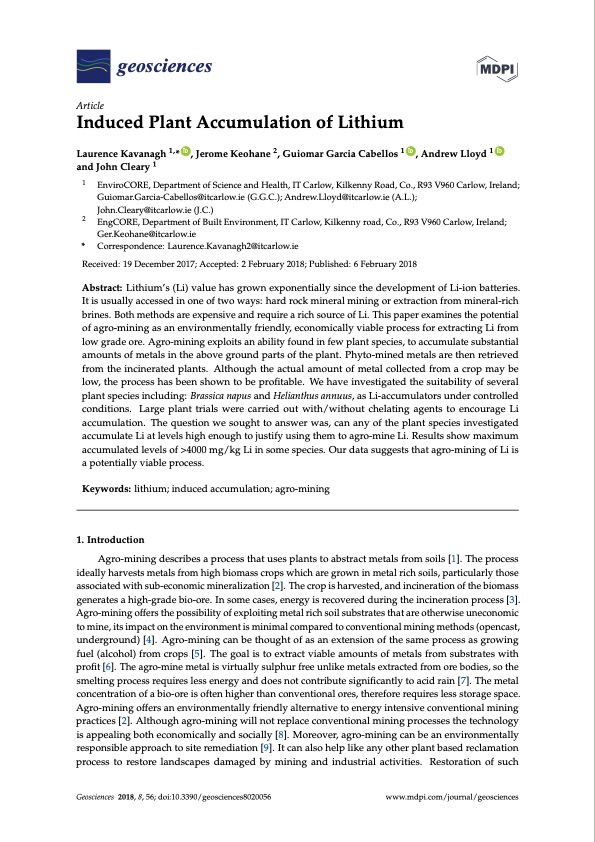
PDF Publication Title:
Text from PDF Page: 001
geosciences Article Induced Plant Accumulation of Lithium Laurence Kavanagh 1,* ID , Jerome Keohane 2, Guiomar Garcia Cabellos 1 ID , Andrew Lloyd 1 ID and John Cleary 1 1 2 * Correspondence: Laurence.Kavanagh2@itcarlow.ie Received: 19 December 2017; Accepted: 2 February 2018; Published: 6 February 2018 Abstract: Lithium’s (Li) value has grown exponentially since the development of Li-ion batteries. It is usually accessed in one of two ways: hard rock mineral mining or extraction from mineral-rich brines. Both methods are expensive and require a rich source of Li. This paper examines the potential of agro-mining as an environmentally friendly, economically viable process for extracting Li from low grade ore. Agro-mining exploits an ability found in few plant species, to accumulate substantial amounts of metals in the above ground parts of the plant. Phyto-mined metals are then retrieved from the incinerated plants. Although the actual amount of metal collected from a crop may be low, the process has been shown to be profitable. We have investigated the suitability of several plant species including: Brassica napus and Helianthus annuus, as Li-accumulators under controlled conditions. Large plant trials were carried out with/without chelating agents to encourage Li accumulation. The question we sought to answer was, can any of the plant species investigated accumulate Li at levels high enough to justify using them to agro-mine Li. Results show maximum accumulated levels of >4000 mg/kg Li in some species. Our data suggests that agro-mining of Li is a potentially viable process. Keywords: lithium; induced accumulation; agro-mining 1. Introduction Agro-mining describes a process that uses plants to abstract metals from soils [1]. The process ideally harvests metals from high biomass crops which are grown in metal rich soils, particularly those associated with sub-economic mineralization [2]. The crop is harvested, and incineration of the biomass generates a high-grade bio-ore. In some cases, energy is recovered during the incineration process [3]. Agro-mining offers the possibility of exploiting metal rich soil substrates that are otherwise uneconomic to mine, its impact on the environment is minimal compared to conventional mining methods (opencast, underground) [4]. Agro-mining can be thought of as an extension of the same process as growing fuel (alcohol) from crops [5]. The goal is to extract viable amounts of metals from substrates with profit [6]. The agro-mine metal is virtually sulphur free unlike metals extracted from ore bodies, so the smelting process requires less energy and does not contribute significantly to acid rain [7]. The metal concentration of a bio-ore is often higher than conventional ores, therefore requires less storage space. Agro-mining offers an environmentally friendly alternative to energy intensive conventional mining practices [2]. Although agro-mining will not replace conventional mining processes the technology is appealing both economically and socially [8]. Moreover, agro-mining can be an environmentally responsible approach to site remediation [9]. It can also help like any other plant based reclamation process to restore landscapes damaged by mining and industrial activities. Restoration of such EnviroCORE, Department of Science and Health, IT Carlow, Kilkenny Road, Co., R93 V960 Carlow, Ireland; Guiomar.Garcia-Cabellos@itcarlow.ie (G.G.C.); Andrew.Lloyd@itcarlow.ie (A.L.); John.Cleary@itcarlow.ie (J.C.) EngCORE, Department of Built Environment, IT Carlow, Kilkenny road, Co., R93 V960 Carlow, Ireland; Ger.Keohane@itcarlow.ie Geosciences 2018, 8, 56; doi:10.3390/geosciences8020056 www.mdpi.com/journal/geosciencesPDF Image | Induced Plant Accumulation of Lithium

PDF Search Title:
Induced Plant Accumulation of LithiumOriginal File Name Searched:
geosciences-08-00056.pdfDIY PDF Search: Google It | Yahoo | Bing
Product and Development Focus for Infinity Turbine
ORC Waste Heat Turbine and ORC System Build Plans: All turbine plans are $10,000 each. This allows you to build a system and then consider licensing for production after you have completed and tested a unit.Redox Flow Battery Technology: With the advent of the new USA tax credits for producing and selling batteries ($35/kW) we are focussing on a simple flow battery using shipping containers as the modular electrolyte storage units with tax credits up to $140,000 per system. Our main focus is on the salt battery. This battery can be used for both thermal and electrical storage applications. We call it the Cogeneration Battery or Cogen Battery. One project is converting salt (brine) based water conditioners to simultaneously produce power. In addition, there are many opportunities to extract Lithium from brine (salt lakes, groundwater, and producer water).Salt water or brine are huge sources for lithium. Most of the worlds lithium is acquired from a brine source. It's even in seawater in a low concentration. Brine is also a byproduct of huge powerplants, which can now use that as an electrolyte and a huge flow battery (which allows storage at the source).We welcome any business and equipment inquiries, as well as licensing our turbines for manufacturing.| CONTACT TEL: 608-238-6001 Email: greg@infinityturbine.com | RSS | AMP |